


© 2004-2022 Thomas Jäkel
.
.
Medan
,
the
provincial
capital
of
Northern
Sumatra,
is
a
bustling
city
of
over
2
million
inhabitants
and
a
booming
commercial
centre
for
the
region's
huge
oil
and
agribusiness.
Oil
palm
plantations,
rubber,
cocoa,
rice
and
other
crops
dominate
the
landscape.
There
is
little
natural
forest
left,
and
the area around the famous lake Toba has been denuded by paper factories.

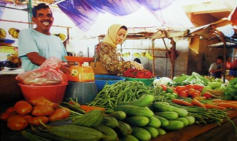
Given
these
circumstances,
I
was
not
expecting
any
exciting
location
to
observe
Wagler's
vipers
in
the
wild.
However,
fortunately,
my
view
proved
to
be
completely
wrong.
Thanks
to
local
friends
and
farmers
I
was
able
to
witness
one
of
the
most
dense
populations
of
T.
wagleri
I
have
ever
seen.
I
will
not
mention
the
exact
location
here.
However,
similar
habitats
are
still
abundant
in
the
vicinity
of
Medan, in particular, in the forests that form the edge of the Karo plateau southwest of the city.
I
had
already
spent
numerous
frustrating
hours
of
roaming
around
in
potential
habitats,
e.g.
in
Sibolangit
Botanical
Garden,
around
Lake
Toba,
and
even
in
Gunung
Leuser
National
Park.
The
forests
around
Berastagi
are
also
beautiful,
but
probably
too
high
above
sea
level,
over
1000
m,
to
host temple pit vipers.
As
it
often
comes
with
Wagler’s
viper
in
the
wild
(see
my
notes
on
Templer
Park),
you
have
to
look
in
the
backyard
of
a
house,
or
a
parking
area
of
a
highway
bordering
forest
to
observe
them.
I
exaggerate, but there is some truth in it.
The
location
I
would
like
to
show
you
here
is
a
river
valley
that
is
used
by
smallholder
farmers
to
grow
cocoa,
rice
and
various
fruits
of
the
region,
like
guava,
pineapple,
sugar
palm
etc.
The
slopes
of
the
valley
show
dense
primary
and
secondary
growth
lowland
jungle.
The
climate
is
extremely
moist,
as
indicated
by
abundant
mosses
and
lichens
on
trees
and
on
the
ground.
Because
T.
wagleri
is so abundant in this place, I think the name 'valley of the temple pit viper' would be a suitable one.
.
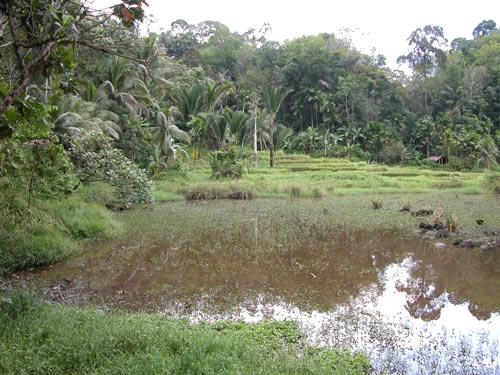
.
Although
the
above
habitat
looked
really
inviting
to
check
for
Waglers,
I
did
not
have
to
venture
too
far
from
the
road
as
the
animals
flocked
the
cocoa
plantations
and
gardens
of
the
local
farmers.
In
fact, this snake is so abundant here that farmers observe it on a daily basis. And they often kill it.
.
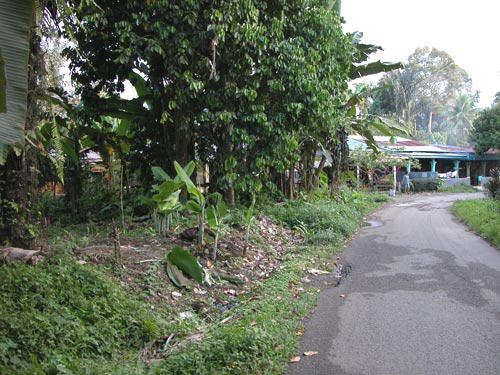
Farmers' houses are surrounded by numerous trees, often fruit trees. The
tree seen in the foreground was inhabitated by temple pit vipers.
.
In
a
period
of
a
five
days,
I
observed
eight
vipers,
and
many
more
were
reported
by
locals.
Unfortunately,
the
snakes
had
disappeared
once
I
arrived
at
those
reported
locations.
Because
it
was
raining
heavily
every
day
(in
the
late
afternoon)
during
this
trip
in
April
2006,
the
snakes
changed
positions
frequently.
Farmers
told
me
that
they
may
stay
at
the
same
place
for
many
weeks.
So
why
is
T.
wagleri
so
abundant
here?
Well,
for
sure
it
is
the
high
humidity
found
in
this
place,
the
close
vicinity
of
the
natural
forest,
and
the
abundance
of
food,
probably
increased
by
humans
through agriculture.
Birds
and
squirrels
were
abundant
in
the
trees,
as
well
as
house
geckos
and
the
Tockay
(
Gekko
gecko
), the call of which is easy to recognize.
.
.
Do you see the viper? It shows a subadult
female. Move over the image to enlarge! This
image was taken in a garden of a farmer's
house.
.
Locals
reported
that
also
brown-colored
tree
vipers
can
be
found
in
cocoa
plantations.
They
usually
can
be
seen
there
only
in
the
morning.
Afterwards,
they
disappear
(probably
into
the
leaf
litter,
which
forms
a
thick
layer
under
cocoa
trees).
Based
on
these
reports,
I
guess,
it
is
Trimeresurus
borneensis
,
but
this
has
to
be
confirmed.
Additionally,
I
observed
a
large
specimen
of
Trimeresurus
hageni
(now
Parias hageni
).
.
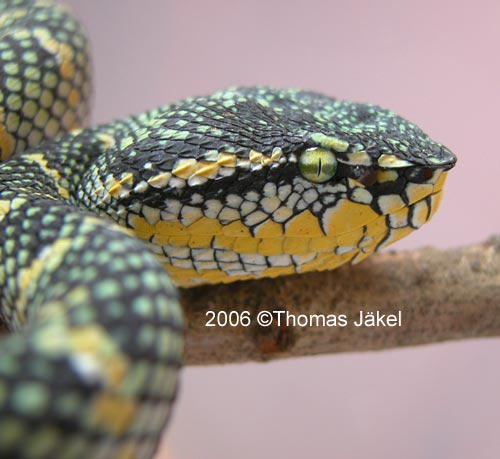
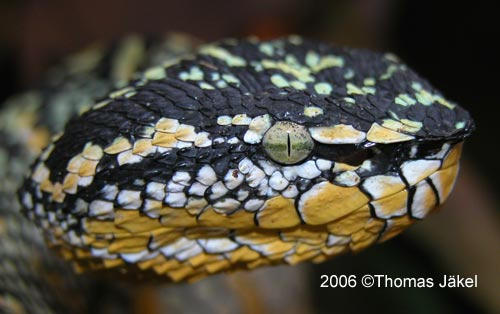
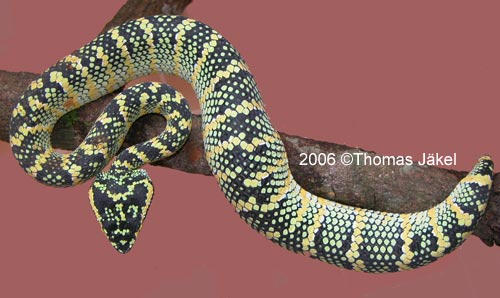
Above: Three adult females from the 'valley of temple pit vipers'. All animals
were photographed under daylight conditions.
.
All
adult
females
that
I
saw
were
gravid,
at
a
time
(February-April)
that
is
consistent
with
observations
in
Thailand
or
Western
Malaysia.
The
juvenile
male
seen
below
was
captured
mid
of
April, thus, it was probaly born recently.
.
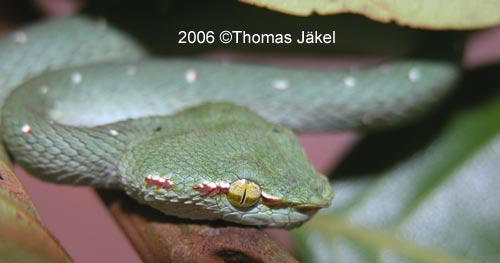
Juvenile male, about 20 cm long. Note the basically blue coloration of the scales.
.
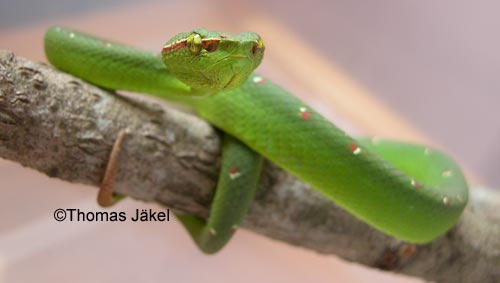
Adult, entirely green male. This snake was collected from a sugar palm tree,
several meters above the ground.
.
Two
vipers
(adult
male
and
subadult
female),
which
were
observed
in
the
trees
high
above
the
ground,
were
in
an
ambush
position
with
the
head
and
forebody
pointing
upwards
(see
image
below).
This
was
probably
because
they
were
waiting
for
birds
or
squirrels
to
pass
by.
In
contrast,
on
occasions
when
I
saw
these
vipers
on
plants
a
few
centimeter
above
the
forest
floor,
they
usually
rested
their
body
on
a
twig
or
leaf
with
the
tail
upwards
and
the
head
pointing
downwards
(see
male
viper
in
Sarawak
section).
Of
course,
this
all
makes
perfectly
sense,
yet,
I
had
not
seen
the
ambush
position
in
trees
so
clearly
before.
It
also
appeared
to
me
that
they
preferred
broad-leafed
trees,
but
this based on very few observations.
.
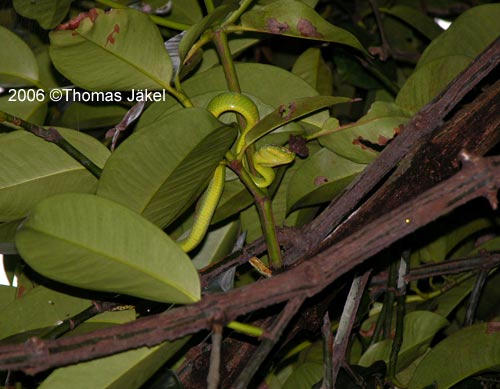
Subadult female, in transition to adulthood, resting in a tree about four meters
above the ground, waiting in ambush for prey.
.
It
is
the
combination
of
smallholder
agriculture
in
relative
harmony
with
nature
that
makes
this
place
special.
The
forests
in
this
valley
are
protected,
mainly
because
they
are
part
of
a
watershed
area that provides water so vital for the constantly growing city of Medan.
It
is
also
encouraging
that
local
farmers
try
to
adopt
environmentally
friendly
ways
of
agriculture
by
practising
organic
farming
for
instance
(it
was
my
professional
interest
in
agriculture
that
brought
me
here
in
the
first
place).
In
view
of
that,
I
hope
that
they
will
succeed
to
preserve
this
beautiful
spot, and with it all the Wagler’s vipers and other magnificent wildlife living here.
.
.
Special Feature 2006:
A trip to a temple pit viper population in the
vicinity of Medan, North Sumatra


© 2004-2021 Thomas Jäkel

© 2004-2018 Thomas Jäkel
.
.
Medan
,
the
provincial
capital
of
Northern
Sumatra,
is
a
bustling
city
of
over
2
million
inhabitants
and
a
booming
commercial
centre
for
the
region's
huge
oil
and
agribusiness.
Oil
palm
plantations,
rubber,
cocoa,
rice
and
other
crops
dominate
the
landscape.
There
is
little
natural
forest
left,
and
the
area
around
the
famous
lake
Toba
has
been denuded by paper factories.

Given
these
circumstances,
I
was
not
expecting
any
exciting
location
to
observe
Wagler's
vipers
in
the
wild.
However,
fortunately,
my
view
proved
to
be
completely
wrong.
Thanks
to
local
friends
and
farmers
I
was
able
to
witness
one
of
the
most
dense
populations
of
T.
wagleri
I
have
ever
seen.
I
will
not
mention
the
exact
location
here.
However,
similar
habitats
are
still
abundant
in
the
vicinity
of
Medan,
in
particular,
in
the
forests
that
form
the
edge
of
the
Karo
plateau
southwest of the city.
I
had
already
spent
numerous
frustrating
hours
of
roaming
around
in
potential
habitats,
e.g.
in
Sibolangit
Botanical
Garden,
around
Lake
Toba,
and
even
in
Gunung
Leuser
National
Park.
The
forests
around
Berastagi
are
also
beautiful,
but
probably
too
high
above
sea
level,
over 1000 m, to host temple pit vipers.
As
it
often
comes
with
Wagler’s
viper
in
the
wild
(see
my
notes
on
Templer
Park),
you
have
to
look
in
the
backyard
of
a
house,
or
a
parking
area
of
a
highway
bordering
forest
to
observe
them.
I
exaggerate, but there is some truth in it.
The
location
I
would
like
to
show
you
here
is
a
river
valley
that
is
used
by
smallholder
farmers
to
grow
cocoa,
rice
and
various
fruits
of
the
region,
like
guava,
pineapple,
sugar
palm
etc.
The
slopes
of
the
valley
show
dense
primary
and
secondary
growth
lowland
jungle.
The
climate
is
extremely
moist,
as
indicated
by
abundant
mosses
and
lichens
on
trees
and
on
the
ground.
Because
T.
wagleri
is
so
abundant
in
this
place,
I
think
the
name
'valley
of
the
temple
pit
viper'
would
be
a suitable one.
.
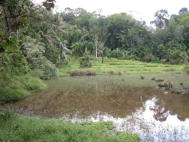
.
Although
the
habitat
on
the
right
looked
really
inviting
to
check
for
Waglers,
I
did
not
have
to
venture
too
far
from
the
road
as
the
animals
flocked
the
cocoa
plantations
and
gardens
of
the
local
farmers.
In
fact,
this
snake
is
so
abundant
here
that
farmers
observe
it
on
a
daily
basis.
And they often kill it.
.
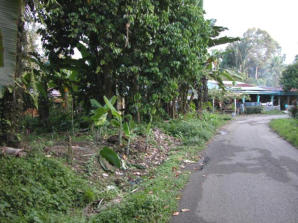
Farmers' houses are surrounded by numerous trees, often
fruit trees. The tree seen in the foreground was
inhabitated by temple pit vipers.
.
In
a
period
of
a
five
days,
I
observed
eight
vipers,
and
many
more
were
reported
by
locals.
Unfortunately,
the
snakes
had
disappeared
once
I
arrived
at
those
reported
locations.
Because
it
was
raining
heavily
every
day
(in
the
late
afternoon)
during
this
trip
in
April
2006,
the
snakes
changed
positions
frequently.
Farmers
told
me
that
they
may stay at the same place for many weeks.
So
why
is
T.
wagleri
so
abundant
here?
Well,
for
sure
it
is
the
high
humidity
found
in
this
place,
the
close
vicinity
of
the
natural
forest,
and
the
abundance
of
food,
probably
increased
by
humans
through
agriculture.
Birds
and
squirrels
were
abundant
in
the
trees,
as
well
as
house
geckos
and
the
Tockay
(
Gekko
gecko
),
the
call
of
which
is
easy
to
recognize.
.
.
Do you see the viper? It shows a
subadult female. Move over the
image to enlarge! This image was
taken in a garden of a farmer's
house.
.
Locals
reported
that
also
brown-colored
tree
vipers
can
be
found
in
cocoa
plantations.
They
usually
can
be
seen
there
only
in
the
morning.
Afterwards,
they
disappear
(probably
into
the
leaf
litter,
which
forms
a
thick
layer
under
cocoa
trees).
Based
on
these
reports,
I
guess,
it
is
Trimeresurus
borneensis
,
but
this
has
to
be
confirmed.
Additionally,
I
observed a large specimen of
Trimeresurus hageni
(now
Parias hageni
).
.
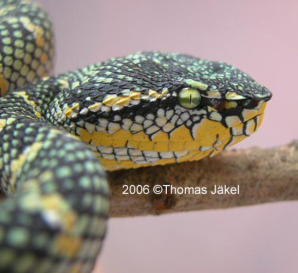
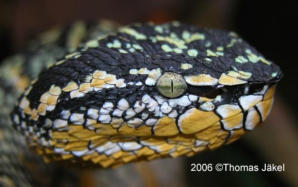
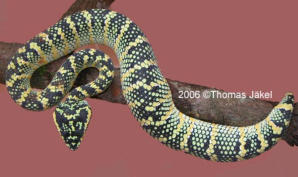
Above: Three adult females from the 'valley of temple
pit vipers'. All animals were photographed under
daylight conditions.
.
All
adult
females
that
I
saw
were
gravid,
at
a
time
(February-April)
that
is
consistent
with
observations
in
Thailand
or
Western
Malaysia.
The
juvenile
male
seen below was captured mid of April, thus, it was probaly born recently.
.
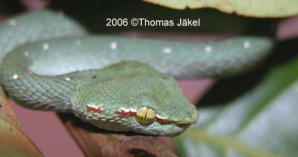
Juvenile male, about 20 cm long. Note the basically blue
coloration of the scales.
.
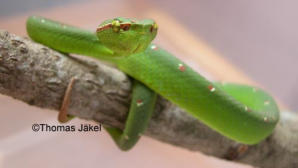
Adult, entirely green male. This snake was collected from a
sugar palm tree, several meters above the ground.
.
Two
vipers
(adult
male
and
subadult
female),
which
were
observed
in
the
trees
high
above
the
ground,
were
in
an
ambush
position
with
the
head
and
forebody
pointing
upwards
(see
image
below).
This
was
probably
because
they
were
waiting
for
birds
or
squirrels
to
pass
by.
In
contrast,
on
occasions
when
I
saw
these
vipers
on
plants
a
few
centimeter
above
the
forest
floor,
they
usually
rested
their
body
on
a
twig
or
leaf
with
the
tail
upwards
and
the
head
pointing
downwards
(see
male
viper
in
Sarawak
section).
Of
course,
this
all
makes
perfectly
sense,
yet,
I
had
not
seen
the
ambush
position
in
trees
so
clearly
before.
It
also
appeared
to
me
that
they preferred broad-leafed trees, but this based on very few observations.
.
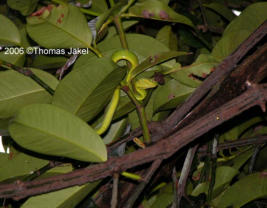
Subadult female, in transition to adulthood, resting in a tree
about four meters above the ground, waiting in ambush for
prey.
.
It
is
the
combination
of
smallholder
agriculture
in
relative
harmony
with
nature
that
makes
this
place
special.
The
forests
in
this
valley
are
protected,
mainly
because
they
are
part
of
a
watershed
area
that
provides
water
so
vital for the constantly growing city of Medan.
.
.
Special Feature 2006:
A trip to a temple pit viper population in the
vicinity of Medan, North Sumatra



- Home
- Wagler's Viper Site (WVS)
- General Husbandry - WVS
- Breeding - WVS
- Health Problems - WVS
- Taxonomy and Phylogenetics - WVS
- Biology - WVS
- Geographic Variability - WVS
- How Females Change - WVS
- Venom - WVS
- Image Map - WVS
- Special: T. laticinctus - WVS
- Special: North Sumatra - WVS
- Special: Video on Mating - WVS
- Special: North Sulawesi - VVS
- Biological Rodent Control - BRC
- Rodent Management Laos - BRC
- Gallery
- Contact









